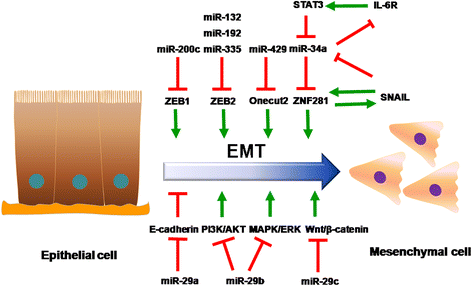MicroRNAs in colorectal carcinoma--from pathogenesis to therapy
- PMID: 26964533
- PMCID: PMC4787051
- DOI: 10.1186/s13046-016-0320-4
MicroRNAs in colorectal carcinoma--from pathogenesis to therapy
Abstract
Background: Acting as inflammatory mediators, tumor oncogenes or suppressors, microRNAs are involved in cell survival, death, epithelial-mesenchymal transition and metastasis, etc. Investigating the communication between microRNAs and tumorigenesis is critical to our understanding of the pathogenesis of multiple disease states.
Main body: Currently, colorectal carcinoma (CRC), one of the most common malignancies worldwide, has a poor prognosis due to lack of an effective therapeutic option. Increasing evidence has identified altered profiles and regulatory potential of microRNAs in conditions related to environmentally-caused colorectal inflammation and colitis-associated cancer. Many studies have shed light on a more thorough understanding of the function and distribution of microRNAs in CRC initiation and emergence. However, the molecular mechanisms by which microRNAs modulate cellular processes still need to be further elucidated and may offer a foundation for evaluating microRNA-based therapeutic potential for CRC in both animal models and clinical trials.
Conclusion: In this review, the roles and mechanisms of microRNAs involved in CRC from pathogenesis to therapy are summarized and discussed, which may provide more useful hints for CRC prevention and therapy.
Keywords: Cancer therapy; Colorectal carcinoma; Diagnosis; MicroRNA; Pathogenesis.
Figures


References
Publication types
MeSH terms
Substances
LinkOut - more resources
Full Text Sources
Other Literature Sources
Medical

